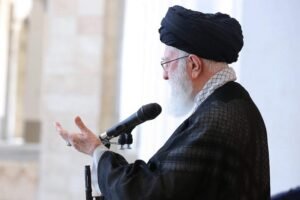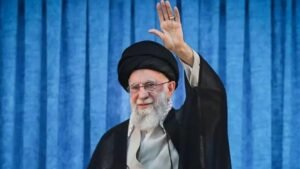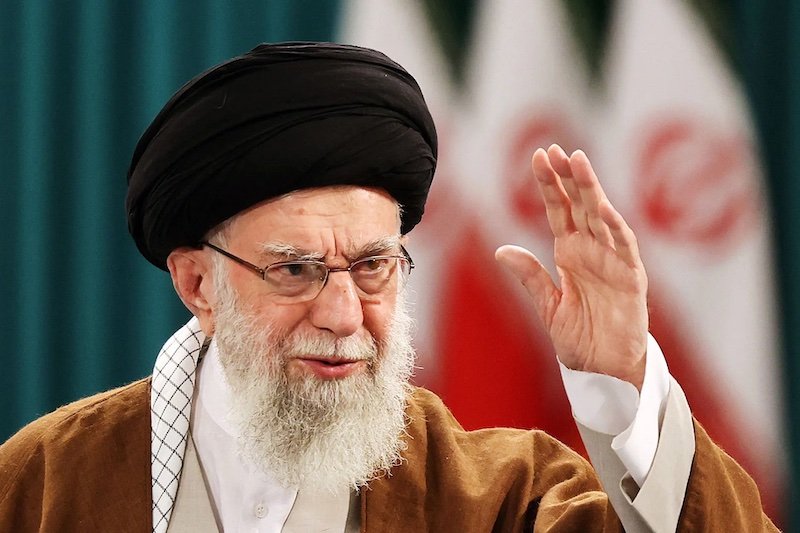Ayatollah Ali Khamenei biography: Iran’s Supreme Leader and Shadow Ruler. Discover the full life story of Iran’s Supreme Leader, Ayatollah Ali Khamenei—his net worth, family, hidden life, rumored successor, and the latest 2025 news surrounding his rule.
Introduction: Iran’s Most Powerful Man
“America and Zionism are the enemies of the Islamic Republic. Their smiles mean nothing. We must be vigilant.” —Ayatollah Ali Khamenei
Ayatollah Ali Khamenei stands as one of the most influential, enigmatic, and controversial leaders of the 21st century. Born on April 19, 1939, in Mashhad, Iran, he rose from a modest clerical background to become the Supreme Leader of Iran in 1989, wielding near-absolute authority over the nation’s military, judiciary, and political landscape for over 36 years. At 86 in 2025, amid escalating tensions with Israel, health rumors, and whispers of succession, Khamenei remains the unyielding heart of the Islamic Republic.
This Ayatollah Ali Khamenei biography explores his net worth, wife, children, potential successor, rumored hiding, and the latest 2025 news, offering a lens into a man whose grip on power shapes Iran and the Middle East.
Why This Biography Matters
- Uncover the contradictions of a leader who lives modestly yet controls vast wealth.
- Understand his role in Iran’s defiance against global powers in 2025.
- Connect with the uncertainty surrounding his succession and Iran’s future.
Quick Fact: Khamenei controls Setad, an organization with assets estimated at $95–$200 billion.
The Turning Point: Becoming Supreme Leader in 1989
In June 1989, following the death of Ayatollah Ruhollah Khomeini, Ali Khamenei was unexpectedly chosen as Iran’s Supreme Leader by the Assembly of Experts. At 50, he lacked Khomeini’s charisma and senior clerical rank, holding only the title of Hojatoleslam. Critics doubted his ability to lead, but his loyalty to Khomeini and political acumen secured his appointment.
Constitutional changes, approved in a July 1989 referendum, loosened clerical qualifications and centralized power, enabling Khamenei to consolidate authority over the military, judiciary, and media. As former president Hashemi Rafsanjani noted, “Ali was chosen for his unwavering commitment to the revolution.” This moment transformed Khamenei from a secondary figure into Iran’s ultimate decision-maker.
Key Insights from This Moment
- Impact: Shifted Iran’s power structure toward a single leader’s dominance.
- Character: Revealed Khamenei’s cunning and strategic pragmatism.
- Legacy: Set the stage for 36 years of ideological and military control.
Pullquote: “Ali was chosen for his unwavering commitment to the revolution.” —Hashemi Rafsanjani

Beyond the Spotlight: Unexplored Dimensions of Ayatollah Ali Khamenei
Khamenei’s public image as a stern cleric masks a complex life shaped by revolution, faith, and survival.
The Revolutionary Activist
From the 1960s, Khamenei protested the Shah’s regime, enduring multiple imprisonments. His fiery sermons and ties to Khomeini made him a revolutionary stalwart, earning him a seat on the Revolutionary Council in 1979.
The War Strategist
As president (1981–1989), Khamenei navigated the Iran-Iraq War, forging ties with the Islamic Revolutionary Guard Corps (IRGC). His survival of a 1981 bomb attack, which maimed his right arm, bolstered his revolutionary credentials.
The Economic Overlord
Khamenei oversees Setad, a vast organization controlling assets worth $95–$200 billion, including real estate, oil, and telecoms. Despite his modest lifestyle, Setad’s wealth cements his economic influence.
The Private Family Man
Khamenei keeps his family shielded, with his wife, Mansoureh, and children rarely appearing publicly. His son Mojtaba’s growing influence hints at a dynastic ambition uncommon in Iran’s theocracy.
| Hidden Facet | Details | Source |
|---|---|---|
| Revolutionary Activist | Imprisoned for anti-Shah activism | Historical records |
| War Strategist | Led during Iran-Iraq War, survived assassination | The Economic Times, June 18, 2025 |
| Economic Overlord | Controls Setad’s $95–$200 billion empire | Reuters, 2013; Celebrity Net Worth, June 16, 2025 |
| Family Man | Shields family, promotes son Mojtaba | The SportsGrail, June 16, 2025 |
His World: The Forces That Shaped Ayatollah Ali Khamenei
Born in Mashhad to a religious family, Khamenei’s father, a cleric, and his second wife, Khadijeh Mirdamadi, raised him in modest circumstances. Studying in Qom under Grand Ayatollah Hossein Borujerdi and Ruhollah Khomeini, he embraced Twelver Shia theology and anti-imperialist ideals.
The 1979 Islamic Revolution, coupled with Khomeini’s mentorship, propelled him into roles like deputy defense minister and president. The Iran-Iraq War (1980–1988) and U.S. hostility hardened his anti-Western stance.
Shaping Forces
- Mentors: Ruhollah Khomeini, Hossein Borujerdi.
- Peers: Hashemi Rafsanjani, Mir-Hossein Mousavi.
- Cultural Context: 1979 Islamic Revolution, anti-imperialism.
Pullquote: “Resistance is the only way to overcome arrogance.” —Ayatollah Ali Khamenei
Visualizing Ayatollah Ali Khamenei: A Timeline Snapshot
A concise timeline traces Khamenei’s key milestones, enhancing accessibility.
| Year | Milestone | Impact |
|---|---|---|
| 1979 | Joined Revolutionary Council | Entered revolutionary elite |
| 1981 | Elected president, survived bomb attack | Gained national prominence |
| 1989 | Appointed Supreme Leader | Consolidated absolute power |
| 2015 | Approved JCPOA nuclear deal | Balanced pragmatism with skepticism |
| 2025 | Faced Israel strikes, succession rumors | Navigated regional crisis |
Accessibility Note: A timeline outlining Ayatollah Ali Khamenei’s journey, from revolutionary activist to Supreme Leader.

Legacy in 2025: Ayatollah Ali Khamenei’s Modern Resonance
In 2025, Khamenei’s 36-year rule faces unprecedented challenges. Israel’s June strikes on Tehran, targeting IRGC commanders, weakened his Axis of Resistance, including Hezbollah and Hamas. The fall of Syria’s Bashar al-Assad in December 2024 diminished Iran’s regional influence.
Domestically, protests following Jina Mahsa Amini’s 2022 death and economic woes fuel unrest. Yet, Khamenei’s control over the IRGC, judiciary, and media endures, and his nuclear ambitions—reaffirmed in June 2025—keep Iran a global flashpoint. His legacy of defiance and theocratic rule shapes Middle East geopolitics.
Impact Metrics
| Metric | Value | Source |
|---|---|---|
| Years as Supreme Leader | 36 | Historical records |
| Setad Assets | $95–$200 billion | Reuters, 2013; Celebrity Net Worth, June 16, 2025 |
| IRGC Personnel | ~150,000 | Reuters, June 17, 2025 |
Interactive Element: Poll: What defines Khamenei’s legacy most? (e.g., Nuclear program, Regional influence, Domestic control)
Khamenei’s Political Strategy
Khamenei’s leadership blends ideological rigidity with “heroic flexibility,” a term he coined in 2013 to justify tactical compromises. He approved the 2015 JCPOA nuclear deal for sanctions relief but rejected U.S. talks in 2019, calling them “poison.” His strategy relies on the IRGC and Basij to suppress dissent, as seen in the 2009 Green Movement and 2022 protests.
He manipulates elections, disqualifying reformists to ensure loyalists like Mahmoud Ahmadinejad and Ebrahim Raisi prevail, while maintaining a veneer of democracy. His foreign policy prioritizes proxy groups like Hezbollah, extending Iran’s reach despite 2025 setbacks.
Key Strategic Elements
- Flexibility: Balances hardline rhetoric with pragmatic deals.
- Control: Uses IRGC to enforce domestic loyalty.
- Proxies: Builds regional influence via Axis of Resistance.
Pullquote: “We will never give in to the pressures of the enemies.” —Ayatollah Ali Khamenei
His Impact on Iran’s Theocracy
Khamenei transformed Iran’s theocracy into a centralized power structure under the Supreme Leader. Constitutional changes in 1989 eliminated the prime minister’s role, enhancing his authority. He enforces velayat-e faqih (guardianship of the jurist), ensuring clerics dominate governance.
His veto power over elected officials, as seen with Ahmadinejad in 2011, underscores his supremacy. By appointing loyalists to the judiciary and Council of Guardians, he stifles reform, shaping a conservative parliament in 2020 and Raisi’s 2021 presidency. His theocratic model faces 2025 scrutiny amid youth unrest.
Theocratic Contributions
- Centralization: Strengthened Supreme Leader’s role.
- Ideology: Enforced velayat-e faqih doctrine.
- Suppression: Curtailed reformist movements.
Pullquote: “The future belongs to the oppressed nations, not the oppressors.” —Ayatollah Ali Khamenei

The Anti-Western Influence
Khamenei’s deep mistrust of the West, rooted in the Shah’s U.S.-backed regime, defines his foreign policy. He labels America and Israel as “arrogant powers,” funding proxies like Hamas and Hezbollah to counter them. His nuclear program, pursued since the 2000s, aims to deter Western intervention, though he issued a 2003 fatwa against nuclear weapons.
In 2025, he rejected Trump’s March negotiation offer, calling it “bullying,” yet began talks via Oman, reflecting his pragmatic streak. Israel’s June strikes and U.S. threats challenge his anti-Western axis, testing his resilience.
Anti-Western Elements
- Rhetoric: Demonizes U.S. and Israel as enemies.
- Proxies: Supports Hamas, Hezbollah, Houthis.
- Nuclear Stance: Pursues deterrence, negotiates cautiously.
Pullquote: “We cannot surrender under external pressure.” —Ayatollah Ali Khamenei
Voices of Ayatollah Ali Khamenei: Quotes and Perspectives
These quotes capture Khamenei’s resolve and polarizing influence.
Quote 1
“Resistance is the only way to overcome arrogance.” —Ayatollah Ali Khamenei
Context: Spoken during a 2023 sermon, rallying against U.S. sanctions.
Takeaway: Reflects his 2025 defiance amid Israel’s strikes.
Quote 2
“We will never give in to the pressures of the enemies.” —Ayatollah Ali Khamenei
Context: From a 2019 speech, rejecting U.S. nuclear talks.
Takeaway: Echoes his 2025 stance against Trump’s demands.
Quote 3
“The future belongs to the oppressed nations, not the oppressors.” —Ayatollah Ali Khamenei
Context: Shared in 2024, supporting Palestinian resistance.
Takeaway: Frames his legacy as a champion of anti-imperialism.
Quote 4
“We warn America of the consequences of engaging in war.” —Ayatollah Ali Khamenei
Context: Issued in June 2025, responding to U.S. threats.
Takeaway: Signals his readiness to escalate if provoked.
Quote 5
“The Islamic Republic will endure beyond my time.” —Ayatollah Ali Khamenei
Context: From a 2025 address, amid succession rumors.
Takeaway: Highlights his focus on regime survival.

FAQs About Ayatollah Ali Khamenei
These questions address reader curiosities and optimize for long-tail keywords.
1. What Is Ayatollah Ali Khamenei’s Net Worth in 2025?
Khamenei’s personal wealth is estimated at $500 million to $1 billion, though he controls Setad, with assets valued at $95–$200 billion, spanning real estate, oil, and telecoms.
2. Who Is Ayatollah Ali Khamenei’s Wife?
Khamenei married Mansoureh Khojasteh Bagherzadeh in 1964. She maintains a low profile, rarely appearing publicly.
3. How Many Children Does Ayatollah Ali Khamenei Have?
He has six children—four sons (Mojtaba, Mostafa, Masoud, Maysam) and two daughters (Boshra, Hoda). Mojtaba is politically prominent.
4. Is Ayatollah Ali Khamenei Hiding in 2025?
Reports suggest Khamenei is in a Lavizan bunker near Tehran with his family, amid Israel’s June strikes. Trump claimed the U.S. knows his location, calling him an “easy target.” These claims remain unverified.
5. Who Will Succeed Ayatollah Ali Khamenei as Supreme Leader?
Mojtaba Khamenei, his son, is a leading contender, backed by the IRGC. Other candidates include Ayatollah Sadeq Larijani and Hassan Khomeini, though the Assembly of Experts decides.
6. What Are the Latest 2025 News Updates on Ayatollah Ali Khamenei?
In June 2025, Israel struck Tehran, killing IRGC commanders, prompting Khamenei to warn of “irreversible repercussions.” He rejected Trump’s surrender demands, began nuclear talks via Oman, and faces succession speculation after Raisi’s 2024 death.
Conclusion: The Enigma of Ayatollah Ali Khamenei
Ayatollah Ali Khamenei’s journey—from a Mashhad cleric to Iran’s supreme powerbroker—embodies ideological zeal, strategic pragmatism, and unyielding control. At 86, facing health rumors, regional setbacks, and global threats in 2025, he remains Iran’s defining force. His vast wealth, hidden family, and looming succession shape a legacy of resistance and theocracy, leaving the world to ponder Iran’s path after him.

